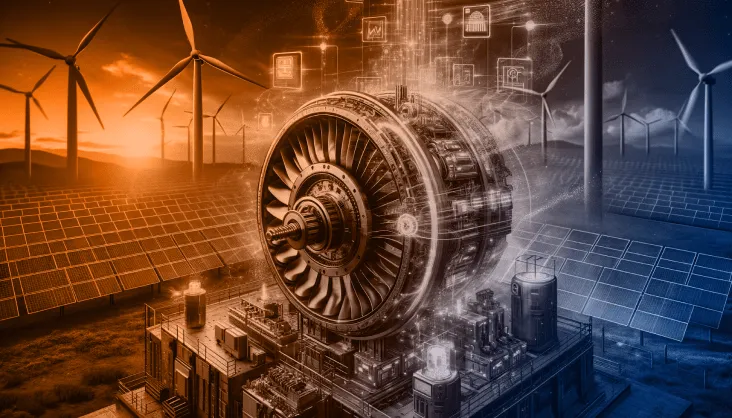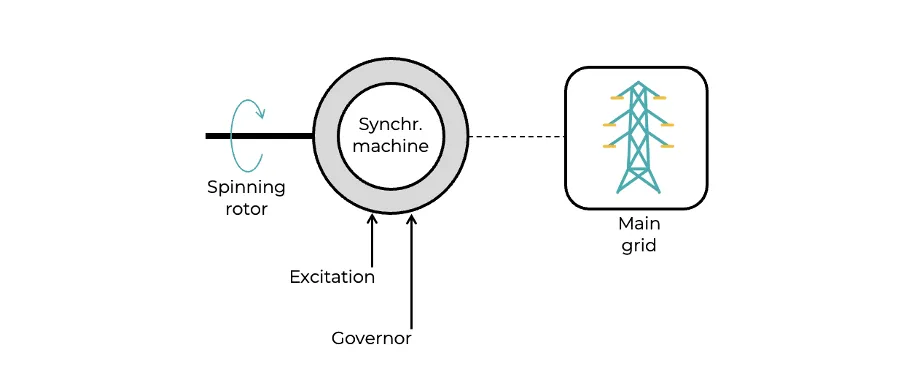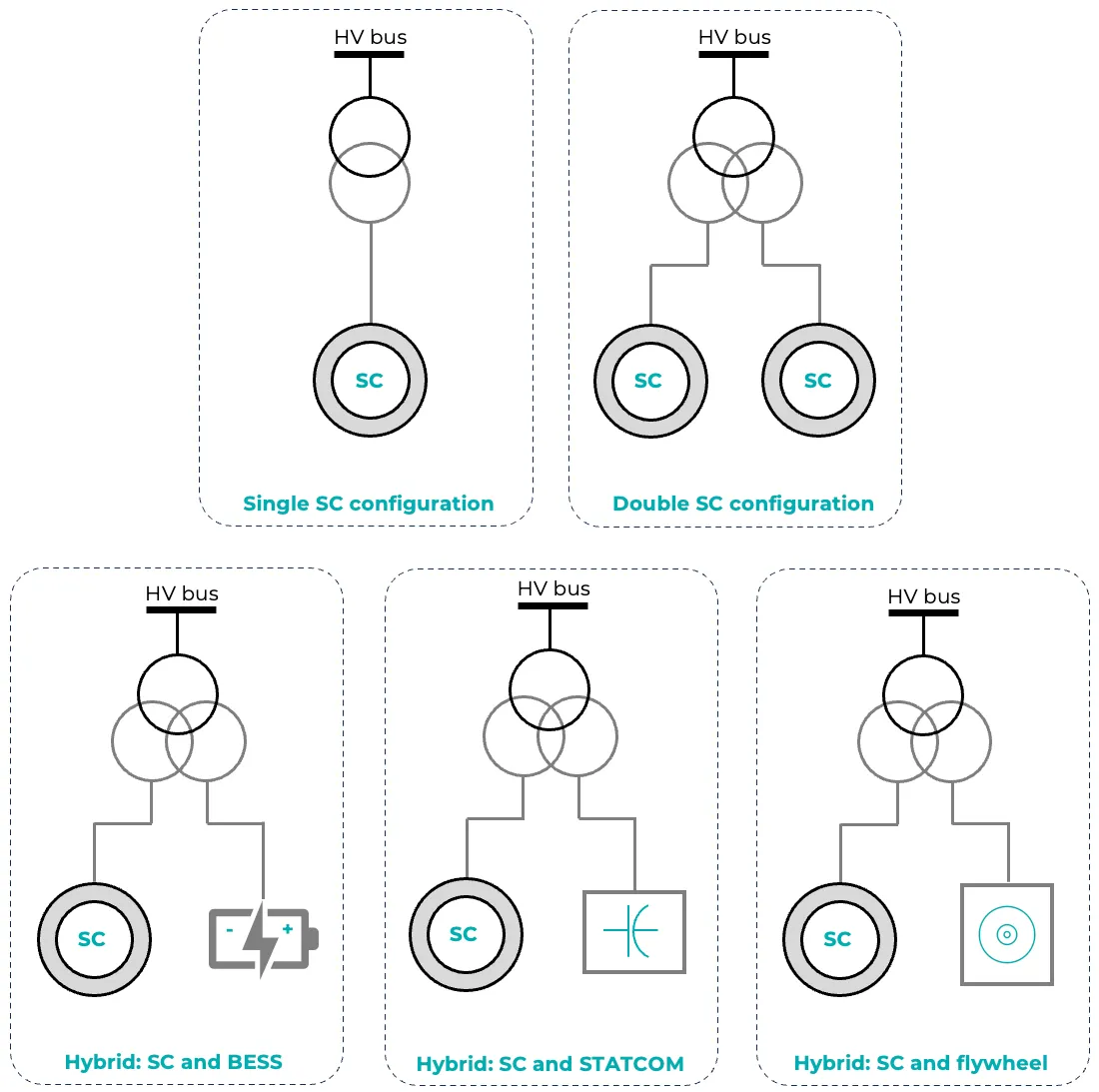Synchronous Condensers: Old-School Workhorse or Future-Proof Grid Stabilisers?
Synchronous Condensers: Old-School Workhorse or Future-Proof Grid Stabilisers?

Introduction:
Synchronous Condensers (SCs) are specialised machine in power grids to manage and regulate electrical power flow and enhance grid stability, fault levels and voltage regulation. They operate on a similar principle as synchronous machines, which are also used in power generation.However, the key difference is that while synchronous machines primarily produce active power by converting mechanical energy to electrical energy, SCs are designed to generate or absorb reactive power. This unique feature allows SCs to adjust conditions on the grid by absorbing or generating reactive power as needed.

This reactive power control is crucial for maintaining the voltage within the desired range and stabilising the grid, especially in systems with high intermittent power sources like wind and solar energy. In simple terms, Reactive power is a type of power that doesn't do any work, but it's necessary to operate many electrical devices. By adjusting the current flow, SCs help to maintain a constant voltage level, which is vital for the efficient transmission and distribution of electrical power. This capability makes them a key component in efforts to enhance the reliability and efficiency of the power grid,particularly as grids evolve to incorporate more renewable energy sources and to manage the complex power flows that result.
During my career, I've had the privilege of being deeply involved in innovative projects that uniquely apply SCs. One example is the NIC-funded PHOENIX project, a groundbreaking collaboration with ABB, DTU, SP Energy Network, and the University of Strathclyde. Our ambitious goal was to integrate a new Hybrid Synchronous Compensator (H-SC) at the Neilston substation in the UK. This practical application of SCs in a real-world setting provided a clear view of how these systems can revolutionise grid stability amidst the increasing integration of renewable energy. The project's success demonstrated the potential of SCs to enhance grid stability and efficiency, paving the way for future advancements in the field.
My involvement around the Stability Pathfinder Framework has underscored the strategic importance of SCs in maintaining grid stability. This experience has given me a deep understanding of SCs and their critical role in our evolving energy landscape, which I'm eager to share to illuminate their importance. By highlighting this strategic importance, I aim to instil confidence in our professional colleagues about their crucial role in the energy industry.
Navigating GridDynamics and the Impact of Synchronous Condensers
In the context of energy transition and the increasing penetration of RES, SCs stand as a beacon of hope, playing a crucial role in addressing several universal grid challenges. These challenges, inherent in the shift towards more sustainable energy sources, underscore the need for reliable solutions to maintain grid stability and efficiency. By stressing the role of SCs in addressing these challenges, I aim to reassure our professional colleagues about the reliability and effectiveness of SCs in the energy industry.
Limited voltage control: As we integrate more renewable energy into the grid, it becomes more complex to control voltage levels. Renewable sources like wind and solar power vary naturally, causing voltage fluctuations. Although SCs do not have prime movers—the driving force of in traditional generators—they can almost match the voltage capability of conventional synchronous generators. This capability stems from the SCs' excitation system, which adjusts to change the reactive power output, thus regulating the grid voltage. Fast VAr services are crucial during transient conditions where rapid voltage fluctuations occur due to sudden changes in the grid, such as fault conditions or abrupt changes in load or generation. SCs can quickly inject or absorb reactive power, thereby mitigating these fluctuations and helping to stabilise the voltage within milliseconds to seconds. This rapid response is comparable to the action of voltage controllers in traditional power plants, ensuring minimal disruption to the grid stability.
On the other hand, slow VAr services contribute to long-term voltage stability. They address the slower, more gradual changes in the grid's voltage profile caused by shifting demand patterns or variations in renewable generation throughout the day. SCs can adjust their reactive power output over minutes to hours, maintaining an optimal voltage level and ensuring a steady electricity supply. Last but not least, SCs' strong voltage control capabilities can play a crucial role in black start scenarios, which are situations where a power grid is restored from a complete shut-down without relying on an external power source.
Lower Short Circuit Level (SCL): The SCL of a power grid is a fundamental metric used to define its strength and robustness. It refers to the maximum current that can flow through a fault in the grid. While it can be considered outdated, it remains a crucial KPI in assessing the grid's ability to handle disturbances and maintain stability. A high SCL indicates a strong, stable system capable of withstanding sudden electrical faults without significant disruption, whereas a low SCL suggests a weaker system, more vulnerable to disturbances and fluctuations. A low SCL is usually synonymous with poor power quality, characterised by increased voltage fluctuations and harmonic distortions. These conditions not only compromise the efficiency and reliability of electrical equipment but also pose challenges to the overall stability of the power grid.
Furthermore, low SCL can impact the performance of protection schemes, particularly distance protection. Distance protection relies on measuring impedance to detect fault locations. However, in systems with low SCL, the impedance values can be misinterpreted, potentially causing these protection schemes to fail or operate incorrectly. This malfunction can lead to delayed fault clearance, escalating the risk of equipment damage and prolonged power outages. The low SCL environment exacerbates the risks associated with high-voltage direct current HVDC links, especially those employing Line Commutated Converters (LCC). LCC HVDC links are power electronic devices used to transmit HVDC over long distances. They are sensitive to the strength of the connected AC systems because they require adequate active power support for proper communication. In scenarios where SCL is low, the risk of commutation failure increases, potentially leading to power transfer disruptions and widespread system instability.
Moreover, the stability of Phase-Locked Loops (PLLs) for converter-interfaced resources like wind turbines and solar inverters is also at stake in low SCL conditions. PLLs are critical for synchronising the output of these converters with the grid. A weak grid, indicated by a low SCL, can lead to PLL misbehaviour, manifesting as difficulties in maintaining synchronisation with the grid frequency. This instability can result in the disconnection of renewable resources from the grid, further straining the grid's operational resilience. In addressing these challenges, SCs emerge as a strategic solution. By effectively raising the SCL, they enhance the system strength, improve power quality, and ensure the reliable operation of protection schemes. Their ability to supply reactive power on demand also supports the stable operation of LCC HVDC links and aids in maintaining the PLL stability for converter-interfaced renewable resources. Consequently, SCs contribute to grid strength and stability and facilitate the seamless integration and operation of diverse energy sources within the power system.
Reduced inertia: Inertia in power systems is fundamentally linked to the grid's ability to resist changes in frequency, acting as a buffer against frequency excursions. Inertia is provided by the rotating masses in synchronous machines, which store kinetic energy. This stored energy can be rapidly converted into electrical energy (or absorbed from the grid) to counteract changes in frequency, thus stabilising the system following disturbances. Although Static Compensators(SCs) typically lack a prime mover and contribute less inertia than conventional power generators, they still significantly impact grid stability. The inertia contribution of SCs directly relates to the rotational mass of their rotors. While this contribution might be low in standard configurations, it is not negligible and becomes particularly valuable in systems phasing out traditional generation sources. To boost their inertia contribution, variations of SC technology have been developed that involve adding extra weights to the rotor. This modification increases the rotor's mass and the stored kinetic energy. By doing so, the SCs can provide a more substantial buffer against frequency fluctuations, improving the grid's overall resilience to power supply and demand changes. The increased inertia provided by these enhanced SCs means that they can better support the grid during sudden frequency excursions, providing a more robust response to shocks such as the sudden loss of a large generator or a significant change in load. This additional inertia is crucial for maintaining grid stability, especially in power systems with high levels of intermittent renewable energy sources, which inherently contribute less to the system inertia.
Benefits of Synchronous Condensers – Let the numbers speak
Various projects are being undertaken in the UK, where I have had the privilege to contribute, and in other countries worldwide.
PHOENIX:
The PHOENIX project, which I was involved in, pioneered a world-first technology by trialling a 140MW Hybrid Synchronous Compensator (H-SC) solution at the Neilston substation in Scotland. This project has demonstrated the following quantified benefits:
Increased Boundary Transfer Capability: The H-SC increased the boundary transfer capability from Scotland to England by 98 MW, facilitating better distribution of renewable electricity generated in the North of Scotland (this boundary increase results in the net cost benefit that can be achieved being £53m to £66m over the asset's life period). More analysis indicated an additional capacity of 662MW to the electricity network.
- Carbon Benefit: The project is estimated to achieve a cumulative carbon benefit of over 16k to 62k, equivalent to the electricity use of over 6,000 homes.
- Net Cost Savings: The H-SC demonstrated net cost benefits ranging from £40 million to £86 million, depending on the FES scenario (details here). These savings are attributed to the improved efficiency and reduced need for ancillary services due to the H-SC's operation.
- Protection performance: Increase 40% distance protection performance, taking 100% penetration of renewables as the basis.
Stability Pathfinder:
In a landmark move following its legal separation from the National Grid Group in 2019, the ESO unveiled an ambitious goal to operate a fully zero-carbon national electricity transmission network by 2025. The Stability Pathfinder initiative is pivotal in realising this vision, introducing innovative technologies to produce essential system properties, notably inertia, without relying on fossil fuels.
- Consumer Savings: Implementing SCs technologies is projected to save up to £128 million over their operational lifespan.
- Carbon Emission Reduction: The anticipated reduction of approximately 6 million tonnes in CO2 emissions underscores this initiative's significant environmental impact.
Other countries and projects:
In various countries, the deployment of SCs is contributing significantly to grid stability and reactive power management (more reading here):
- In Denmark, the Bjæverskov substation has operated 250 MVAr SCs since 2013. By August 2014, the Fraugdeand Herslev substations began utilising an SC system capable of providing over 900 MVA of short-circuit power and +150/-75 MVAr of reactive power.
- In Australia, the grid benefits from four +25/-12.5 MVAr SCs, four 25 MVAr shunt capacitor banks, two phase-shifting transformers, and an integrated control system. The SCs' overload capability allows the 115 kV shunt capacitors to be activated mechanically.
- Germany's regions of Hesse and Bavaria have introduced a converted condenser managing -400 to +900 MVAr of reactive power, aiding the Amprion grid operator during voltage variations. Additionally, an SC providing a range of +340 to -170 MVAr reactive power ensures grid reliability amidst voltage changes.
- Vermont and New Mexico have implemented SCs to enhance grid performance in the USA. Vermont's setup includes four +25/-12.5 MVAr SCs, an accompanying control system and phase-shifting transformers.
- New Mexico's 959 MVA short-circuit capacity at the 362 kV Blackwater station improves voltage support and power transmission. Italy's grid stability in Brindisi and Sardinia benefits from introducing SCs.
- In Brindisi, two units each provide up to +250/-125 MVAr of reactive power and 1750 MWs of inertia, while in Sardinia, two 250 MVAr SCs operating at 3000 rpm and 19 kV voltage contribute to stabilising the grid.
The Evolutionary Design of Synchronous Condenser
SCs epitomise the harmony between durability and adaptability in power grids. The design spectrum of SCs stretches from newly built facilities to the ingenious repurposing of defunct thermal power stations. This flexibility in design underscores the SC's versatility and the industry's resourcefulness.
When contemplating the deployment of SCs, we stand at a crossroads where established methods intersect with pioneering technologies. SCs may be deployed singularly, harnessing the mature technology that has underpinned grid stability for decades, or they can be part of a hybrid ensemble. As shown in Figure 2, hybrid systems integrate SCs with advanced technologies such as STATCOMs, which adeptly manage transient dynamics, or BESS and flywheels, which contribute genuine active power capacity—addressing a gap in traditional SC capabilities.

Amidst the energy sector's shifting tides, a debate persists: Do we revert to the familiar embrace of synchronous machinery, or do we chart a new course with converter-interfaced resources? With its inherent complexity and diversity, the future energy landscape will likely necessitate a portfolio approach where every technology, including synchronous machines, has a role.
This convergence of the old and the new within SC configurations—pairing with STATCOMs, BESS, and flywheels—is less a compromise and more a strategic enhancement. It's an affirmation that grid modernisation is about integrating the best of all worlds: the reliable performance of established technologies and the flexibility of modern innovations.
In the final analysis, synchronous machines, when employed as SCs in concert with newer technologies, exemplify how grid advancements are achieved by amalgamating the time-tested benefits of mature technologies with the dynamic capabilities of contemporary solutions. This integration is a testament not to our reliance on the past but to our progressive vision for the power grid—a vision that embraces the full spectrum of innovation to meet the demands of a sustainable and resilient future.
Joining the Conversation: Orchestrating Grid Stability with Advanced Control Systems
The essence of our journey into power grids—where SCs meet the modernity of BESSand STATCOM—is in recognising the pivotal role of control systems like Omega Suite. These behind-the-scenes maestros truly harmonise the symphony of generators and storage technologies. They enable the smooth, efficient coordination of the grid's diverse components, presenting a continuous challenge that pushes the boundaries of technology.

Your insights into these control systems are crucial. We invite you to contribute to this conversation as we discuss the seamless integration of time-tested and emerging technologies.







